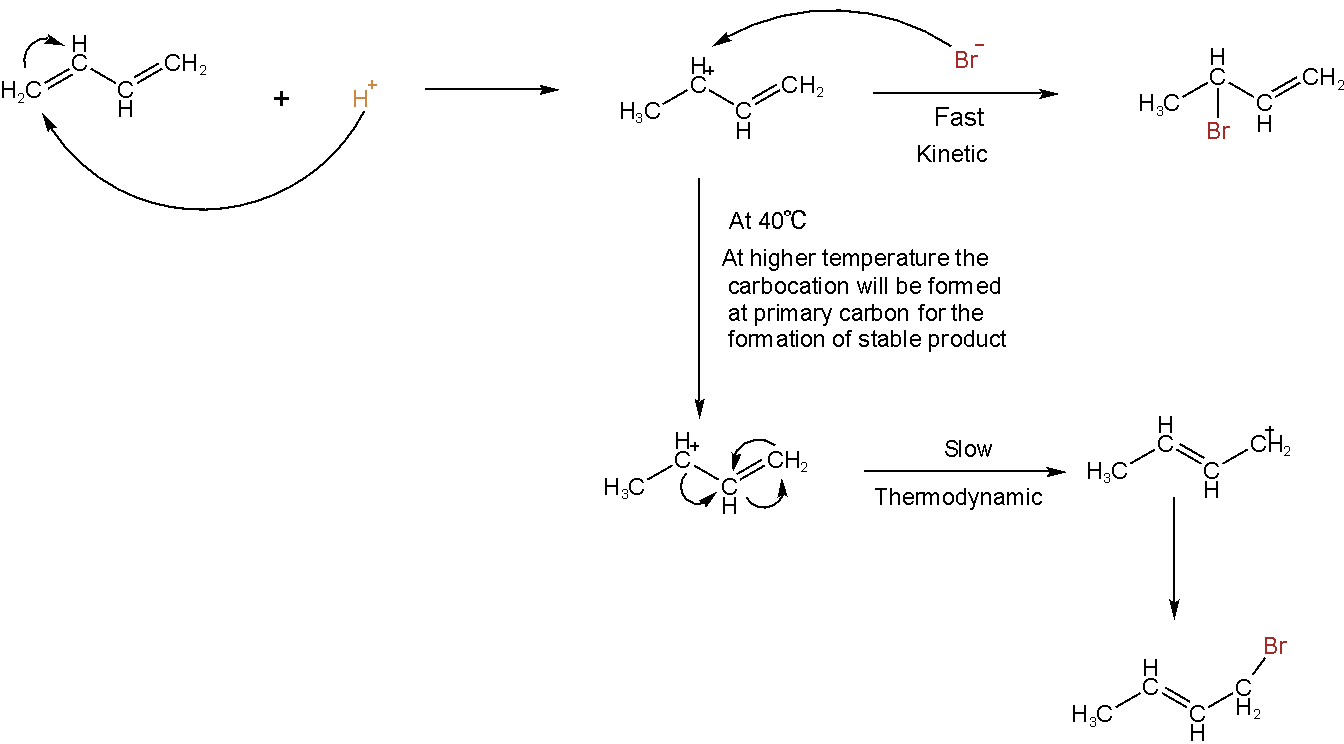
Reaction of one molecule of HBr with one molecule of 1,3-butadiene at 40℃ gives predominantly
A. 3-bromobutene under kinetically controlled conditions
B. 1-bromo-2-butene under thermodynamically controlled conditions
C. 3-bromobutene under thermodynamically controlled conditions
D. 1-bromo-2-butene under kinetically controlled conditions
Answer
219.6k+ views
Hint: The reaction at which the ratio of formation of the product depends on or is determined by the rate of formation of the product, the product formed due to this is called kinetically controlled product, and when the ratio of formation of product is determined by the formation of more stable product, the product formed due to this is called thermodynamically controlled product.
Complete Step by Step Answer:
The conditions under which a kinetically controlled product is formed are called kinetically controlled conditions. A kinetically controlled product is formed on the basis of a fast reaction, the product which is formed at a fast rate.
The conditions under which a thermodynamically controlled product is formed are called thermodynamically controlled conditions. A thermodynamically controlled product is formed when the product formed is based on stability, a thermodynamic product is the most stable product formed in the reaction.
When one molecule of HBr reacts with one molecule of 1,3-butadiene at 40℃, that means there is only one Bromide ion will be formed in the reaction:
$CH_2=CH-CH=CH_2 + \ \ \ HBr\ \ \ \ \rightarrow CH_2Br-CH=CH-CH_3+{\rm CH}_3-CHBr-CH=CH_2$
Since; 1,3-butadiene is a symmetric molecule, the product formed from this reaction is 1-bromo-2-butene and 2-bromo-1-butene. The thermodynamically stable product is 1-bromo-2-butene because the reaction goes through the process of formation of the most stable carbocation.
The formation of the most stable carbocation:

Hence, the product formed is 1-bromo-2-butene under thermodynamically controlled conditions
Thus, Option (B) is correct
Note: In the given reaction Markovnikov’s rule does not apply because of the formation of the most stable product. And Markovnikov rule says that the Nucleophile will only attack the carbon containing less number of hydrogens.
Complete Step by Step Answer:
The conditions under which a kinetically controlled product is formed are called kinetically controlled conditions. A kinetically controlled product is formed on the basis of a fast reaction, the product which is formed at a fast rate.
The conditions under which a thermodynamically controlled product is formed are called thermodynamically controlled conditions. A thermodynamically controlled product is formed when the product formed is based on stability, a thermodynamic product is the most stable product formed in the reaction.
When one molecule of HBr reacts with one molecule of 1,3-butadiene at 40℃, that means there is only one Bromide ion will be formed in the reaction:
$CH_2=CH-CH=CH_2 + \ \ \ HBr\ \ \ \ \rightarrow CH_2Br-CH=CH-CH_3+{\rm CH}_3-CHBr-CH=CH_2$
Since; 1,3-butadiene is a symmetric molecule, the product formed from this reaction is 1-bromo-2-butene and 2-bromo-1-butene. The thermodynamically stable product is 1-bromo-2-butene because the reaction goes through the process of formation of the most stable carbocation.
The formation of the most stable carbocation:

Hence, the product formed is 1-bromo-2-butene under thermodynamically controlled conditions
Thus, Option (B) is correct
Note: In the given reaction Markovnikov’s rule does not apply because of the formation of the most stable product. And Markovnikov rule says that the Nucleophile will only attack the carbon containing less number of hydrogens.
Recently Updated Pages
Electricity and Magnetism Explained: Key Concepts & Applications

JEE Energetics Important Concepts and Tips for Exam Preparation

JEE Isolation, Preparation and Properties of Non-metals Important Concepts and Tips for Exam Preparation

JEE Main 2021 July 25 Shift 1 Question Paper with Answer Key

JEE Main 2021 July 22 Shift 2 Question Paper with Answer Key

States of Matter Chapter For JEE Main Chemistry

Trending doubts
JEE Main 2026: Application Form Open, Exam Dates, Syllabus, Eligibility & Question Papers

Derivation of Equation of Trajectory Explained for Students

Hybridisation in Chemistry – Concept, Types & Applications

Understanding the Angle of Deviation in a Prism

Understanding Atomic Structure for Beginners

How to Convert a Galvanometer into an Ammeter or Voltmeter

Other Pages
NCERT Solutions For Class 11 Chemistry Chapter 7 Redox Reaction

JEE Advanced Marks vs Ranks 2025: Understanding Category-wise Qualifying Marks and Previous Year Cut-offs

Thermodynamics Class 11 Chemistry Chapter 5 CBSE Notes - 2025-26

NCERT Solutions ForClass 11 Chemistry Chapter Chapter 5 Thermodynamics

Hydrocarbons Class 11 Chemistry Chapter 9 CBSE Notes - 2025-26

Equilibrium Class 11 Chemistry Chapter 6 CBSE Notes - 2025-26




